Blind Spot Information System (BLIS) with Cross Traffic Alert(CTA)
WARNING: To help avoid injuries, NEVER use the BLIS® as a replacement for using the interior and exterior mirrors and looking over your shoulder before changing lanes. BLIS® is not a replacement for careful driving and only an assist.
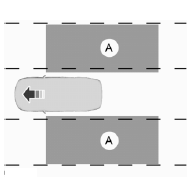
BLIS® aids the driver in detecting vehicles that may have entered the blind spot zone (A). The detection area is on both sides of the vehicle, extending rearward from the exterior mirrors to approximately 10 feet (3 meters) beyond the bumper. The system alerts you if certain vehicles enter the blind spot zone while driving.
BLIS® aids the driver in detecting vehicles that may have entered the blind spot zone (A). The detection area is on both sides of the vehicle, extending rearward from the exterior mirrors to approximately 10 feet (3 meters) beyond the bumper. The system alerts you if certain vehicles enter the blind spot zone while driving.
CTA warns the driver of vehicles approaching from the sides when the transmission is in R (Reverse).
Note: BLIS® is not designed to prevent contact with other vehicles or objects; or to detect parked vehicles, people, animals or infrastructure (fences, guardrails, trees, etc.). It is designed to alert the driver to vehicles in the blind zones.
Note: When a vehicle passes quickly through the blind zone (typically fewer than two seconds), the system does not trigger.
Using the Systems
BLIS® turns on when the engine is started and the vehicle is driven forward above 3 mph (5 km/h); it remains on while the transmission is in D (Drive) and N (Neutral). If shifted out of D (Drive) or N (Neutral), the system enters CTA mode. Once shifted back into D (Drive), BLIS® turns back on when the vehicle is driven above 3 mph (5 km/h).
Note: BLIS® does not function in R (Reverse) or P (Park) or provide any additional warning when a turn signal is on.
CTA detects approaching vehicles from up to 45 feet (14 meters) away though coverage decreases when the sensors are blocked. Reversing slowly helps increase the coverage area and effectiveness.
WARNING: To help avoid personal injury, NEVER use the CTA system as a replacement for using the interior and exterior mirrors and looking over your shoulder before backing out of a parking space. CTA is not a replacement for careful driving and only an assist.
In this first example, the left sensor is only partially obstructed; zone coverage is nearly maximized.
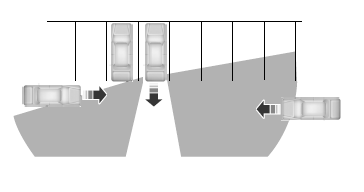
Zone coverage also decreases when parking at shallow angles. Here, the left sensor is mostly obstructed; zone coverage on that side is severely limited.
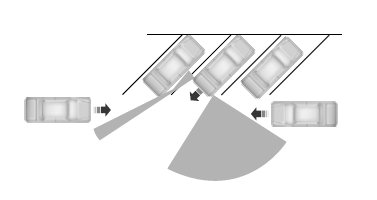
System Lights and Messages
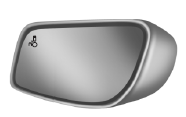
The BLIS® and CTA systems illuminate a yellow alert indicator in the outside mirror on the side of the vehicle the approaching vehicle is coming from.
Note: The alert indicator dims when the headlamp switch is not in the off position and nighttime darkness is detected.
CTA also sounds a series of tones and a message appears in the information display indicating a vehicle is coming from the right or left.
CTA works with the reverse sensing system which sounds its own series of tones; see the Parking Aids chapter
System Sensors
WARNING: Just prior to the system recognizing a blocked condition and alerting the driver, the number of missed objects will increase. To help avoid injuries, NEVER use the BLIS® as a replacement for using the side and rear view mirrors and looking over your shoulder before changing lanes. BLIS® is not a replacement for careful driving and only an assist.
Note: It is possible to get a blockage warning with no blockage present; this is rare and known as a false blockage warning. A false blocked condition either self-corrects or clears after a key cycle.
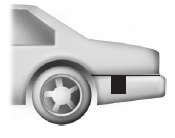
The system uses radar sensors which are located behind the bumper fascia on each side of the vehicle. Do not allow these areas to become obstructed by mud, snow or bumper stickers, as this can cause degraded system performance.
If the system detects a degraded performance condition, BLIND SPOT NOT AVAILABLE, or CROSS TRAFFIC NOT AVAILABLE appear in the information display and the alert indicator illuminates in the appropriate mirror(s). The information display warning can be cleared but the alert indicator remains illuminated.
When the blockage is removed, the system can be reset in two ways: 1) when at least two objects are detected while driving, or 2) turn the ignition key from on to off, then back on. If the blockage is still present after the key cycle, the system senses again that it is blocked after driving in traffic.


System Limitations
The BLIS® and CTA systems do have their limitations; situations such as severe weather conditions or debris build-up on the sensor area may limit vehicle detection.
The following are other situations that may limit the BLIS®:
• Certain maneuvering of vehicles entering and exiting the blind zone.
• Vehicles passing through the blind zone at very fast rates.
• When several vehicles forming a convoy pass through the blind zone.
The following are other situations that may limit the CTA system:
• Adjacently parked vehicles or objects obstructing the sensors.
• Approaching vehicles passing at speeds greater than 15 mph (24 km/h).
• Driving in reverse faster than 3 mph (5 km/h).
• Backing out of an angled parking spot.
False Alerts
Note: If the vehicle has a factory equipped tow bar, and it is towing a trailer, the sensors will detect the trailer and turn the BLIS off to avoid false alerts. For non-factory equipped tow bars you may want to turn the BLIS off manually.
There may be certain instances when either the BLIS® or CTA systems illuminate the alert indicator with no vehicle in the coverage zone; this is known as a false alert. Some amount of false alerts are normal; they are temporary and self-correct.
System Errors
If either system senses a problem with the left or right sensor, the BLIS® indicator in the information display will illuminate and remain on.
Also, BLIND SPOT SYSTEM FAULT or CROSS TRAFFIC SYSTEM FAULT message will appear. When problems that may cause the left or right indicator not to illuminate, only the information display message faults appear.
Switching the Systems Off and On
One or both systems can be switched off temporarily by using the information display control; refer to the Information Display chapter.
When the BLIS® is switched off, the driver does not receive alerts and the information display shows BLIND SPOT SYS OFF and/or CTA SYSTEM OFF. The system switches back on whenever the ignition is switched on.
One or both systems can also be switched off permanently at your authorized dealer. Once switched off, switching it back on must also be done at the dealership.
See also:
Repairing minor paint damage
Your authorized dealer has touch-up paint to match your vehicle’s color.
Take your color code (printed on a sticker in the driver’s door jamb) to your
authorized dealer to make sure you get the ...
Parking Aids
Sensing system
WARNING: To help avoid personal injury, please read and understand the
limitations of the system as contained in this section. Sensing is only an aid for
some (generally large and ...
Special operating conditions
If you operate your vehicle primarily in any of the following conditions, you
need to perform additional maintenance as indicated. If you occasionally operate
your vehicle under any of these condi ...
